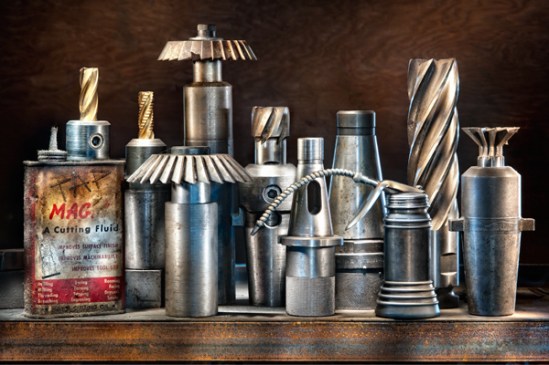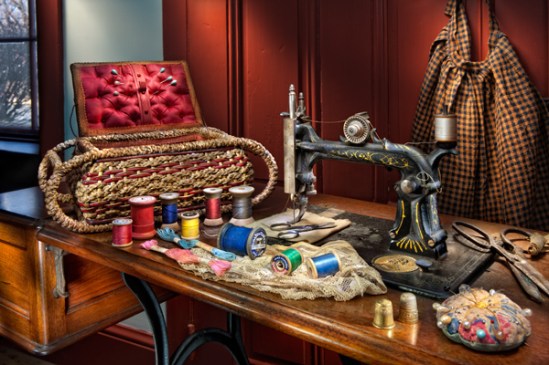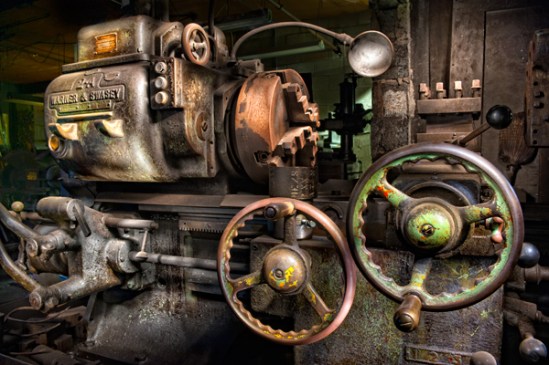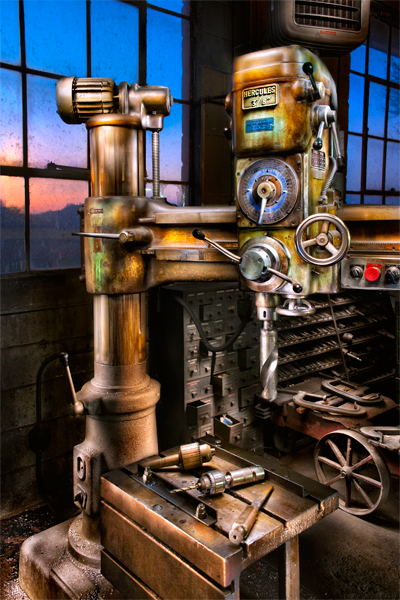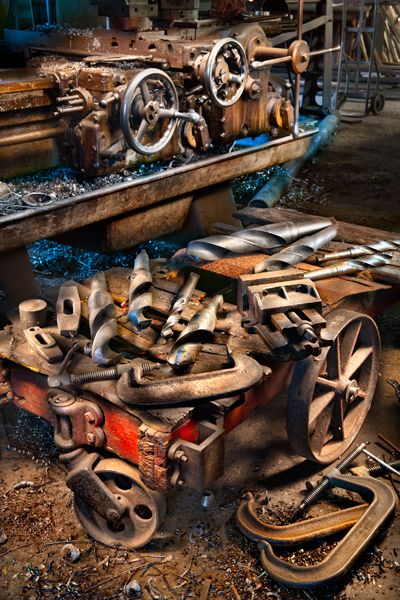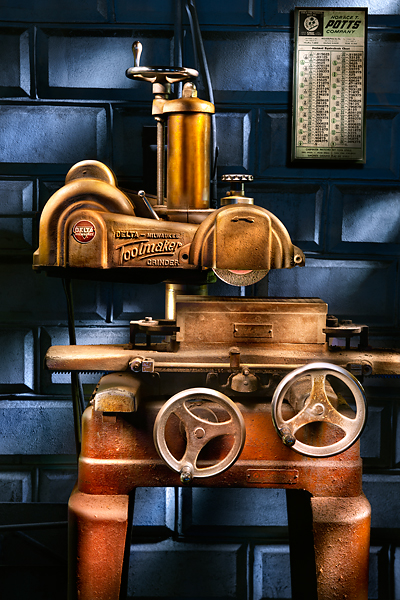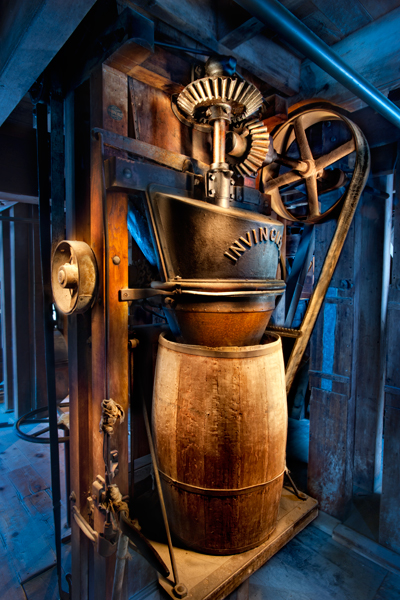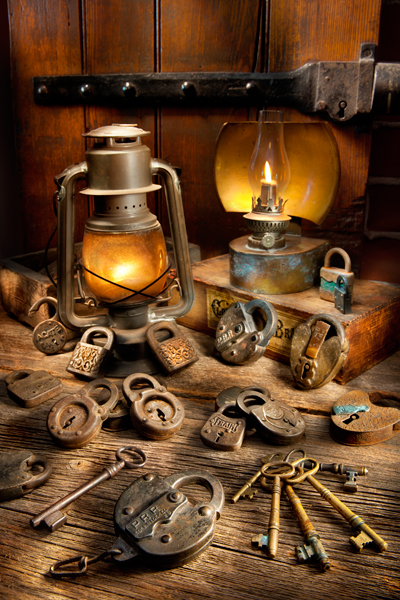Lancaster county has countless skilled craftsmen that still take pride in their work. From woodworkers who build custom furniture, to master leather craftsmen who supply the local community with leather goods, to those who work with various metal products,a rich heritage of doing things by hand still exists today. I recently was in search of a piece of copper for a project and a friend directed me to a small shop he knew of out in the countryside. I pulled in the driveway of the address I was given and the small building in front of me gave no hint of what I was about to see. As I walked in the dark unlit interior, I was immediately drawn to a beautiful copper train that was being built one piece at a time for a customer. The level of detail was amazing and spoke to the skill of the metalsmith who was building it. After a brief conversation, I decided to ask if he would consider allowing me to come back one evening and photograph it? The answer was sure,but he told me the train was being picked up that night and an immediate feeling of missing a chance to record something special came over me. He did tell me he was making another two trains for this customer and maybe in the future,I could try a shot? We got each others phone numbers and I headed off thinking about the missed opportunity, but to my amazement, the phone rang that evening and he told me it would be here for another day, and if I wanted to come back,he would be there all evening. I immediately said yes and gathered my gear to head over. All the way there, I worried I was not going to come up with a way to capture the train because it is actually a weathervane and has a tube and support attached and it does not just sit on a table. The owner was very patient with me and was more than happy to move things around to get the right setup for the shot. My final composition shown above included the recently finished copper train, with the very first copper train that has been treated with a patina to give it an aged look in the background. I wish I could recognize the man who built this train, but in the interest of privacy ,all you need to know is that he is just one of Lancaster counties many skilled craftsmen.There is no electricity here or fancy tools, just talent and hard work and I was certainly impressed.
Category Archives: tools
A mind boggling display.
If you ever get the chance to visit the Mercer Museum in Doylestown,Pa,take it because it will blow your mind.This place is a time capsule featuring items from past times that were saved and displayed by a man on a mission who had a great vision to save history for future generations.It is several stories of thousands of items one may never see anywhere else.Shown in this photo on the lower left is an 1800 fire engine pumper that is just one small part of the collection and hangs by huge chains from the second story concrete walls. I had to hand hold everything,and bracing your camera for 1 second exposures can be a bit challenging.
Henry Mercer was a gentleman anthropologist. On a cruise up the Ruhr in early adulthood, Mercer was impressed by the eclipse of artisanal culture by industrial production, and resolved himself to preserving artifacts of pre-industrial life. In the late 19th and early 20th centuries, Mercer collected pre-industrial tools and other implements of the past. He believed that the story of human progress and accomplishments was told by the tools and objects that people used and saw these time-honored crafts slowly disappearing from memory.
Mercer personally designed plans for a museum to house his collection, six stories tall and cast of poured-in-place concrete. Mercer’s museum was completed in 1916. In addition to tools, it displays furnishings of early Americana, carriages, stove plates, a gallows, antique fire engines, a whaleboat, and the Lenape Stone. The Spruance Library, which houses the Bucks County Historical Society’s archive of historical research materials, is located on its third floor.
Spring Palette
 Spring is advancing rapidly and this most special time of year will soon fade away. I photographed this lovely garden scene that is located within an easy walk from my home and this was shot with winds in the 5-10 mph range, and for this type of work,that’s a little strong. The owners were not home,so I had to light everything from the sidewalk,and wish I had been able to get in different angles with my flash,but this turned out nicely despite that. The scene was shot with a 70-200 mounted on a tripod and linked to my laptop. I used radio poppers to fire the wireless flash,and a wireless transmitter to fire the camera. I shot about 50 frames,lighting the plants as needed and then brought the pieces together for the result. The owner takes great pride in the property and has a wide variety of unique plants throughout the season. The Wisteria was my main objective,and its fragrant blooms were a delight to see and smell.
Spring is advancing rapidly and this most special time of year will soon fade away. I photographed this lovely garden scene that is located within an easy walk from my home and this was shot with winds in the 5-10 mph range, and for this type of work,that’s a little strong. The owners were not home,so I had to light everything from the sidewalk,and wish I had been able to get in different angles with my flash,but this turned out nicely despite that. The scene was shot with a 70-200 mounted on a tripod and linked to my laptop. I used radio poppers to fire the wireless flash,and a wireless transmitter to fire the camera. I shot about 50 frames,lighting the plants as needed and then brought the pieces together for the result. The owner takes great pride in the property and has a wide variety of unique plants throughout the season. The Wisteria was my main objective,and its fragrant blooms were a delight to see and smell.
Steamroller Fun
This is another example of experimenting with deer spotlights on a subject. Admittedly,I still need more practice to master this technique,but each try proves to be fun. The top photo is no spot light and the bottom is the result of about twenty separate twenty-second exposures at f11 using the spotlight. I used a wireless remote to fire my camera and also use a laptop to review what I did on each exposure to keep track what was lit already and as a reference if I need to shine the light at a different angle for better effect. Doing that also keeps you from touching the camera and creating registration problems. My spotlight has a diffuser and a snoot to keep the camera from being able to see the light source as I stand in the scene. The steamroller has the name Fordson on its radiator grill.
Big Red
The Rolling Behemoth
Ever feel tiny and insignificant? Well that’s probably how the driver of this compact car felt as he hugged the curb and kept a little distance between himself and this rolling monstrosity. This huge Combine was on the move through several local towns recently as it made it way to the next cornfield for more harvesting, and it raised eyebrows more than once as it dominated the road. I shot this through my car window after I was lucky enough to get directly behind it. The only thing better than this would have been a smart car beside it,which would really look ridiculous.
Feed Mill Pelletizer
 Once again I was trying my light painting technique in the old feed mill. This time I was photographing what I think is called a pelletizer, which makes feed pellets and the two images show the machine in a closed, and then open position.The bottom photo shows the machines main part,which has a series of holes that form the hardened pellets. The room was very warm so I assume some heat process is involved as well. To do the two images,I first completed the scene with it closed and then simply opened the door for the next part of the shoot. Then I brought that image on top of the first and blended them.
Once again I was trying my light painting technique in the old feed mill. This time I was photographing what I think is called a pelletizer, which makes feed pellets and the two images show the machine in a closed, and then open position.The bottom photo shows the machines main part,which has a series of holes that form the hardened pellets. The room was very warm so I assume some heat process is involved as well. To do the two images,I first completed the scene with it closed and then simply opened the door for the next part of the shoot. Then I brought that image on top of the first and blended them.
The Food Chain
Have you ever seen so many cobwebs,you thought you were on the set of some science fiction thriller? Well this was the case as both myself and a fellow photographer spent an evening shooting in a local feed mill. I walked around looking for a shot and came across this corner of the mill that seemed lost in time. It’s no wonder spiders have laid claim to this place as flies were a real nuisance while we shot. I light painted this with an off camera flash trying to bring out the webs and dust and dirt as best I could. At least no mice ran by me on this visit. I have no idea what the machine does but it must not get used very often.
Beyond Thunderdome
 Call me crazy, but this reminds me of some wild set of wheels from the movie Thunderdome. If you look closely in the middle underneath you can see a machine gun mounted,or maybe its just a muffler? Put some muscle-bound maniac on top going down the road at 100 mph and you have your own futuristic movie in the making. Shot this at the rough and tumble event, which showcased old farm equipment.
Call me crazy, but this reminds me of some wild set of wheels from the movie Thunderdome. If you look closely in the middle underneath you can see a machine gun mounted,or maybe its just a muffler? Put some muscle-bound maniac on top going down the road at 100 mph and you have your own futuristic movie in the making. Shot this at the rough and tumble event, which showcased old farm equipment.
Steam Powered Past
 Machines from the past fascinate me, and these old steam-powered contraptions are no exception. Rough and Tumble located in scenic Lancaster county held their 64th annual threshermans reunion last week, and the event included all kinds of steam,gas and kerosene powered machines. This old steam roller with its massive iron wheels was one of many unique pieces I saw at this event.
Machines from the past fascinate me, and these old steam-powered contraptions are no exception. Rough and Tumble located in scenic Lancaster county held their 64th annual threshermans reunion last week, and the event included all kinds of steam,gas and kerosene powered machines. This old steam roller with its massive iron wheels was one of many unique pieces I saw at this event.
Picture perfect harvest
Mechanized Marvels
I was out looking for scenes of local farm activity and came across this crew doing custom harvesting. The farm owner graciously allowed me to wander around shooting various angles of these mechanized marvels that help make short work of what seems like daunting tasks at times. The crews are hired independently to come in and do the work, which saves the farmer having to buy extremely expensive equipment and is a win-win situation for everyone. The first shot was taken from the roof of my truck and was taken while the harvester off loaded his collecting bin into the waiting tractor,and the second shot is from ground level. Thanks to Groffdale custom harvesting for taking a few minutes to let me get the shots. While watching them work the fields, I saw numerous rabbits bolt, and amazingly enough a fox as well. I need to check my files,but I think he was out of the frame when He made a dash for it.
I did actually get the fox leaving the wheat field. He is a tiny speck on the photo,but here he is.
Synchronized Driving 2
Synchronized Driving
I photographed this crew this week harvesting what I think is wheat, but I could be way off. They have to work in close proximity to one another and their driving was spot on. This was taken with an 80-400 zoom and I could actually see them in the cab talking on two-way radios,most likely about the guy taking their photo. At one point,there were three tractors lined up to catch the crop, but they never went across the field with more than the two shown here.
Run for the hills
I went out in search of lightning photos the other night, and even though the skies looked pretty threatening, no lightning ever materialized. As I headed home I passed this piece of farm equipment sitting at a local business and decided to light paint it with a flash. I named the photo ”run for the hills” because between the sky ,and the front end of this contraption, I thought it looked pretty menacing. Its called a forage harvester,and I think it does corn but it may have other uses for all I know.
Weighing the options
This image was taken at the feed mill that I had photographed and featured on my blog a few days ago. I met Brad the owner, and he graciously allowed both myself and fellow photographer Larry the chance to look around inside. After the mill shut down for the day, we broke out our gear and we each selected an area to light paint. Admittedly it has been a while since I gave this technique a try, so I struggled a bit as I worked to light the room with my spotlight. The mill is a real labyrinth of metal and wood, and left me wondering how such a place is designed. The inside also included numerous cats roaming about, which surprised me with all the machines at work, but after I had witnessed a cat catch a mouse three feet in front of me, it all became clear very quickly. The area I chose included the old scale with the two feed bags on it, along with another scale facing the opposite direction with the number 122 on it. The blue light is coming from window light that was shining in at dusk. We usually work in the dark, but time constraints had us shooting earlier.
Mechanical marvel
Pardon my brevity with today’s post, but I was hammered with two migraines in one day today, which is very rare for me, so as I type this, I pretty much feel like this machine is sitting on my head. Sometimes when the weather changes, These things can hit me for whatever reason. So hopefully I did not post this shot before, and my apologies if I did.
Color vs Black & White
I usually go with one image a day, but I thought Since these two shots are of the same subject, yet look totally different, it might be interesting to see color vs black and white, First, let me say the color shot actually makes no sense to the trained eye of a machinist, but to a layman like myself, it looked perfect. The set of bits on the right were sitting a short distance from this machine, so I decided they must be used on that machine and I proceeded to place them there. I was pretty far into the shot when the owner walked by, and told me they have no relation to each other, but I was already committed at that point. The black and white was the first image I shot using old oil cans, but for some reason it did not work in color, so I abandoned the cans for the bits. Either way, I like both shots almost equally,but I really like the textures in the black and white.
Weighing the options
Today I visited a local florist that is planning to open an antique shop in the near future, and he graciously allowed me to look through his collection for possible photo subjects. I saw the old scale first and then selected several items to add some balance and color to the shot. I have no idea where some of my ideas come from, but I decided fruit would look neat on the scale, so I zipped over to a nearby produce stand and picked up a selection of limes,lemons and apples. For budding photographers taking notes, I light painted this shot using my small flashlight, and because the room had numerous windows, I used a 3 stop neutral density filter on the lens, which allowed me to shoot exposures around 8 seconds each. The window directly behind the shot was covered by black fabric till the very end, and then the exposure for the window portion was simply painted in on lighten mode in layers in Photoshop. Thanks to Kerry for giving me free reign in the shop.
Machine shop End Mills
Many of you may have deduced by now that I have been thoroughly enjoying my visits to the old machine shop, and each trip is an opportunity to practice my light painting techniques in the hopes of getting better. This past trip had me trying to come up with some earth shattering image, which wasted an hour of time till I finally decided to shoot this detail shot of end mills and tool holders that were on a shelf. I added the cool oil can and rustic old cutting oil can to spice up the shot. I settled on the tighter shot because I wanted my shots to have some diversity to them. The background is just a wood panel that was part of the shelf unit, and I lit it with a flashlight.
A Stitch in Time
I spent the morning sunday shooting with my friend larry who is light painting master, and we each did our best to do something unique at our local historical society. I chose an old sewing machine, and friends Margi and Dan loaned me several antique sewing items to help bring the shot to life. I used small pen flashlights and my big spotlight to accent the pieces, and the shot took me nearly an hour and a half to do. The best I could figure was this sewing machine is one made by the man who got the first patent for a lock stitch design in 1846, and his name was Elias Howe. Mr Howe had to defend his patent in court from 1849-1854, because he found that Isaac Singer, and Walter Hunt had been selling a facsimile of his machine and lockstitch design. He eventually won the case and won considerable royalties from singer. I can imagine the many hands that worked diligently on this machine in the late 1800s and early 1900s, creating garments and necessities for the family. My grandmother was a great quilter and I remember her working countless hours on her old sewing machine doing patches,and a few times over the years she would relay the stories of how a needle had gone straight through her finger and nail while sewing.
The Turret Lathe
This is another machine shop undertaking, and once again the layers of color and texture drew me to photograph it. The best I could make out was that it is a turret lathe, but don’t hold me to that. I checked in the folder I save my files in and I had shot eleven separate files to light this as shown. Many times I will shoot triple that amount so I don’t miss any piece of the puzzle. As I have mentioned before, a sturdy tripod, a basic laptop and a few flashlights are all you need.
Peeling Paint
Working Late Tonight
Todays image is one of several from my shoot at the machine shop yesterday. This place has so much history and character in every nook and cranny, that I become overwhelmed at times trying to decide which subject to shoot. I chose what I believe to be a drill press for a shot at dusk because it was positioned right at the windows where the sunset colored the evening sky outside. The patina of oil,dirt,metal shavings and everything else provided the perfect canvas to light paint. Lee who owns the shop graciously allowed myself and a friend several hours of uninterrupted shooting, which was really appreciated. I picked the title because we started shooting around 4pm and finished at 9pm, and a worker from the day shift was still running a mill in the back room to catch up on several jobs for clients as we were heading home to bed. You couldn’t ask for a more accommodating crew than the guys who help us shoot there.
Ready for Work
This is the second image from the machine shop that I visited last week. It was fairly light inside the shop,so exposures could not be any longer than 8 seconds, which complicates the whole light painting process, unless of course you are using flash, which I find slightly harder to control in these situations. The reason I prefer flashlights is because I can do a quick test run at certain angles to see what looks the best before tripping the shutter. The various tools used in this shop are quite impressive, and personally I have never seen drill bits on such a heavy-duty scale. The rustic old cart full of tools was just perfect for light painting,and the lathe provided a nice backdrop for the cart.
Old School vs New
One more variation featuring the old Remington typewriter. A good friend volunteers at a local computer recycling center, so I asked him to borrow a few old keyboards to use as a backdrop for the typewriter. I had the idea to contrast the old technology with the current. Obviously things were made a little better in those days. I basically skimmed the flashlight across the keyboards to accent the keys.
The Daily Grind
I am always on the lookout for things that appeal to me as possible photo subjects and I recently made contact with a gentleman that owns a local machine shop. I had stopped by one day for another purpose and while I was standing in the office, I noticed some old machine shop equipment in the back. Everything had a rich patina of dust, grease, and everything in between from years of jobs being performed. These machines go back many decades, are built like a tank, and seem almost indestructible, to me anyway. Everywhere you look, there seems to be endless photo possibilities for those willing to look. You can just feel the history within the shop as your eye moves from machine to machine, and being allowed to photograph there is something I am very grateful for.
The owner not only allowed me and my friend to photograph there, but he also trusted me enough to let me shoot unattended the very first night I was there. This is something that I am very grateful for and do not take for granted. Being all alone in the shop gave me the opportunity to really look for shots that I thought might work with my light painting techniques. For those who read this and enjoy photography, I want to say that I always try to make prints and let the owners use my images as they need in exchange for their generosity. Having the chance to create new images is very important to me, and I am not sure why, but I seem to have a real drive to be creative, even if I am the only person to ever see the work. So in closing, I suggest to always ask if you see something unique that you want to shoot, because you might be pleasantly surprised, and always return the favor in appreciation for someone allowing you into their domain.
I do not know anything about this particular machine, other than it being a heavy-duty grinder. Keep a look out for more great machines from this shop in the future. Again, a special thanks to Lee and his helpful employee who assisted as well.
The Invincible Machine.
Nothing is really invincible, but this machine found in an old mill seems to be very well-built and has the name invincible on its front. A sticker on the beam says invincible cleaners, but I have no clue what it did in the mill operation. Evening light was pouring in the windows while I was lighting the gears and barrel, so we have a cold verses warm effect.This was shot in the same place as yesterdays post, and thanks to no heat inside, temperatures were near freezing, which was actually colder than it was outside. Perhaps that comes from the stream that runs under a portion of the building.
Unlock your Imagination
I chose the title of todays post after my wife and I went out to eat on friday. The restaurant walls had several quotes stenciled on them, and one by Albert Einstein caught my attention. The full quote reads like this, “I am enough of an artist to draw freely upon my own imagination.Imagination is more important than knowledge.Knowledge is limited.Imagination encircles the world”. As an artist, I am constantly looking for inspiration all around me, whether its music, photographs, art, or in this case an inspirational idea, one can enhance their own artistic expression by unleashing their imagination.
Whenever I read a quote like this, I think to myself, I sure wish I could say something so profound, yet so simple, but you can’t have it all I guess. On the topic of creativity, I have always been intrigued by how some people are seemingly born with the gift of creativity, others seem to learn it along the way, and others do not have an artistic bone in their body. Personally I don’t like to even say I am artistically blessed, because I am a small blip in the creative world, but I do feel I have been given a gift from God to capture the beauty around me. I know this because every time I see a gorgeous sunset or scene, I can feel something inside me stir, and am so grateful to have that feeling.
My image today features old locks and was made possible by the Burkholder family who have an antique business. They allowed me into their home to do two shots I had envisioned in my mind. One of the two images was this old group of keys and locks, and I wanted to photograph them in a way to accent their aged quality. I decided to use some old barn wood I had, and put some old lanterns in there as well. I light painted the scene to bring out the textures and shapes, and to make the lanterns glow,I held a lit match near the wick to simulate the glow, simply because these old antiques could not be fired up. The door in the photo is from an old prison and provided the background to complement my shot.
So in conclusion, I wholeheartedly believe that imagination is more important than knowledge, and I encourage anyone that follows my blog to imagine the possibilities you have each day to photograph what you love, and do it in a way that pushes your photos to the next level, and as you do so, may you find great satisfaction in producing something you are proud to put your name to.
A glimpse back in time
 This photograph features the old equipment in a water powered grain mill. This amazing set of machines are still functional, and start right up with the twist of a shaft, which runs two stories to the basement. In the basement there is a huge tank that holds water in reserve, and at a moments notice, the entire operation is ready to go.The date on the machines says patent-1893, and the craftsmanship and build quality is characteristic of an era were necessity was the mother of invention, This is another example of painting with light, and the photography session lasted almost 2 hours and the merging of all the pieces took about 3 hours, but I go in circles sometimes trying to decide which effect I want to pick, so that complicates things a bit. As I have warned in past posts, never bump anything in your shot while doing this, and as usual, I kicked the shovel halfway through, but luckily I had it captured already. Try and find something built to these standards nowadays, and you will be looking a while or digging pretty deep in the pocketbook. The two lower photos represent the base layer on the left, upon which the image is built and that image is a very flat,subdued, dark image,upon which the highlight images are overlayed, and a single light painted sample section,on the right, which includes the flashlight source where I have the arrow pointing. I generally try to keep the light source hidden by my body or simply turned away, so the camera cannot see it. A snoot or shield on the light can help, and even if you see the light source, its irrelevant if that section is not being used.
This photograph features the old equipment in a water powered grain mill. This amazing set of machines are still functional, and start right up with the twist of a shaft, which runs two stories to the basement. In the basement there is a huge tank that holds water in reserve, and at a moments notice, the entire operation is ready to go.The date on the machines says patent-1893, and the craftsmanship and build quality is characteristic of an era were necessity was the mother of invention, This is another example of painting with light, and the photography session lasted almost 2 hours and the merging of all the pieces took about 3 hours, but I go in circles sometimes trying to decide which effect I want to pick, so that complicates things a bit. As I have warned in past posts, never bump anything in your shot while doing this, and as usual, I kicked the shovel halfway through, but luckily I had it captured already. Try and find something built to these standards nowadays, and you will be looking a while or digging pretty deep in the pocketbook. The two lower photos represent the base layer on the left, upon which the image is built and that image is a very flat,subdued, dark image,upon which the highlight images are overlayed, and a single light painted sample section,on the right, which includes the flashlight source where I have the arrow pointing. I generally try to keep the light source hidden by my body or simply turned away, so the camera cannot see it. A snoot or shield on the light can help, and even if you see the light source, its irrelevant if that section is not being used.




















